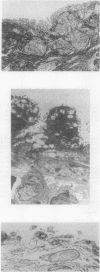Abstract
Giant emphysematous bullae are believed to produce symptoms of pulmonary compression and collapse by containing gas under pressure that has been generated through valvular feeding airways. To examine this hypothesis, we have measured oxygen and carbon dioxide tensions (PO2, PCO2) in four patients and pressure within the bullae in three patients immediately before surgery. During spontaneous tidal respiration PO2 in the bulla was higher than arterial PO2 but did not rise as fast during the breathing of oxygen. The intra-bulla pressure during inspiration was negative (-5.5 to -19 cm H2O) and similar to pleural pressure in phase and degree. During intermittent positive pressure ventilation in two patients airway pressures were transmitted to the bulla with the development of a positive end expiratory pressure within the bulla. Histological examination of the walls of the bullae in the four patients and adjacent lung tissue in an additional patient failed to identify any valvular mechanism. The available information suggests that bullae develop after retraction and collapse of surrounding lung away from a region of weakness.
Full text
PDF





Images in this article
Selected References
These references are in PubMed. This may not be the complete list of references from this article.
- Baydur A., Cha E. J., Sassoon C. S. Validation of esophageal balloon technique at different lung volumes and postures. J Appl Physiol (1985) 1987 Jan;62(1):315–321. doi: 10.1152/jappl.1987.62.1.315. [DOI] [PubMed] [Google Scholar]
- Behrakis P. K., Baydur A., Jaeger M. J., Milic-Emili J. Lung mechanics in sitting and horizontal body positions. Chest. 1983 Apr;83(4):643–646. doi: 10.1378/chest.83.4.643. [DOI] [PubMed] [Google Scholar]
- Carr D. H., Pride N. B. Computed tomography in pre-operative assessment of bullous emphysema. Clin Radiol. 1984 Jan;35(1):43–45. doi: 10.1016/s0009-9260(84)80232-9. [DOI] [PubMed] [Google Scholar]
- Fiore D., Biondetti P. R., Sartori F., Calabró F. The role of computed tomography in the evaluation of bullous lung disease. J Comput Assist Tomogr. 1982 Feb;6(1):105–108. doi: 10.1097/00004728-198202000-00018. [DOI] [PubMed] [Google Scholar]
- Gelb A. F., Gold W. M., Nadel J. A. Mechanisms limiting airflow in bullous lung disease. Am Rev Respir Dis. 1973 Apr;107(4):571–578. doi: 10.1164/arrd.1973.107.4.571. [DOI] [PubMed] [Google Scholar]
- HEAD J. R., AVERY E. E. Intracavitary suction (Monaldi) in the treatment of emphysematous bullae and blebs. J Thorac Surg. 1949 Dec;18(6):761-76, illust; Disc, 798-803. [PubMed] [Google Scholar]
- Morgan M. D., Denison D. M., Strickland B. Value of computed tomography for selecting patients with bullous lung disease for surgery. Thorax. 1986 Nov;41(11):855–862. doi: 10.1136/thx.41.11.855. [DOI] [PMC free article] [PubMed] [Google Scholar]
- Morgan M. D., Strickland B. Computed tomography in the assessment of bullous lung disease. Br J Dis Chest. 1984 Jan;78(1):10–25. [PubMed] [Google Scholar]
- Parmar J. M., Hubbard W. G., Matthews H. R. Teflon strip pneumostasis for excision of giant emphysematous bullae. Thorax. 1987 Feb;42(2):144–148. doi: 10.1136/thx.42.2.144. [DOI] [PMC free article] [PubMed] [Google Scholar]
- Pearson M. G., Ogilvie C. Surgical treatment of emphysematous bullae: late outcome. Thorax. 1983 Feb;38(2):134–137. doi: 10.1136/thx.38.2.134. [DOI] [PMC free article] [PubMed] [Google Scholar]
- Potgieter P. D., Benatar S. R., Hewitson R. P., Ferguson A. D. Surgical treatment of bullous lung disease. Thorax. 1981 Dec;36(12):885–890. doi: 10.1136/thx.36.12.885. [DOI] [PMC free article] [PubMed] [Google Scholar]
- Pride N. B., Hugh-Jones P., O'Brien E. N., Smith L. A. Changes in lung function following the surgical treatment of bullous emphysema. Q J Med. 1970 Jan;39(153):49–69. [PubMed] [Google Scholar]
- TING E. Y., KLOPSTOCK R., LYONS H. A. Mechanical properties of pulmonary cysts and bullae. Am Rev Respir Dis. 1963 Apr;87:538–544. doi: 10.1164/arrd.1963.87.4.538. [DOI] [PubMed] [Google Scholar]



